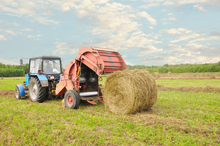First cutting is right around the corner in most parts of the country . . . for most of us this means our barns will need to be ready to store our hay in the next few weeks.

Importance of proper hay storage
First cutting of hay is right around the corner in most parts of the country and for most of us this means our barns will need to be ready to store the hay for our horses and other animals in the next few weeks.
“There’s nothing worse than having a load of new hay and having nowhere to stack it,” says Laurie Cerny, editor and publisher of .good-horsekeeping.com. “Cleaning up your hay stack and storage area should be a constant process, but if it hasn’t been, it’s wise to do it now.”
Here are some tips for better hay storage:
- Clean out the storage area. Remove all hay from previous years. If you have a cement floor – sweep the area out. Rake dirt floors and let the area dry/air out for a few days before stacking your new hay.
- Prepare the storage area. Always put a barrier between the ground and your hay. Wood skids work best to keep the bottom layer off of the ground while still allowing air circulation under the stack. Allow space in between stacks for air circulation and keep stacks at least six inches away from exterior walls (especially walls that heat up during the hot summer days).
- Stack as you feed. Don’t block your hay in . . . .if your feed half first cutting and half second cutting daily make sure you can access both easily.
- Separate different cuttings and different kinds of hay. It’s easy to tell first and second cuttings apart when they’re first baled and stacked. When it starts to fade, however, it’s not so easy. Know where you stack each cutting; you can also tie a tag onto the baler twine indicating the cutting or field the hay came off of.
- Keep a tally record. It’s easy to forget how much hay you’ve stacked in the barn as the season continues.
Write your totals somewhere – either keep a notebook for your farm/stable, or mark it on a barn calendar or note board. This is the only way to know how much hay you have.
For more practical horse care information Comments and suggestions can also be sent to goodhorsekeeping@gmail.com
